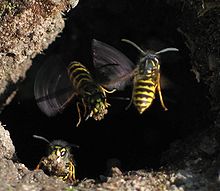
Back ذوات الحمة Arabic ذوات الحمه ARZ İynəlilər Azerbaijani Aculeats Catalan Brodhvepse Danish Stechimmen German Aculeata Esperanto Aculeata Spanish Astlalised Estonian نیشداران Persian
| Aculeata Temporal range:
| |
|---|---|

| |
| Vespula vulgaris | |
| Scientific classification | |
| Domain: | Eukaryota |
| Kingdom: | Animalia |
| Phylum: | Arthropoda |
| Class: | Insecta |
| Order: | Hymenoptera |
| Suborder: | Apocrita |
| Infraorder: | Aculeata (but see text) |
| Superfamilies | |
Aculeata is a subclade of Hymenoptera containing ants, bees, and stinging wasps. The name is a reference to the defining feature of the group, which is the modification of the ovipositor into a stinger. However, many members of the group cannot sting, either retaining the ovipositor, or having lost it altogether. A large part of the clade is parasitic.
This group includes all of the eusocial Hymenopterans. It is theorized that the possession of a venomous sting was important in the repeated evolution of eusociality within Hymenoptera.
The oldest aculeates are known from the Late Jurassic Karabastau Formation of Kazakhstan, represented by the family Bethylonymidae, which may be para- or polyphyletic.[1]
- ^ Grimaldi, David A.; Peñalver, Enrique; Barrón, Eduardo; Herhold, Hollister W.; Engel, Michael S. (2019-11-07). "Direct evidence for eudicot pollen-feeding in a Cretaceous stinging wasp (Angiospermae; Hymenoptera, Aculeata) preserved in Burmese amber". Communications Biology. 2 (1): 408. doi:10.1038/s42003-019-0652-7. ISSN 2399-3642. PMC 6838090. PMID 31728419.